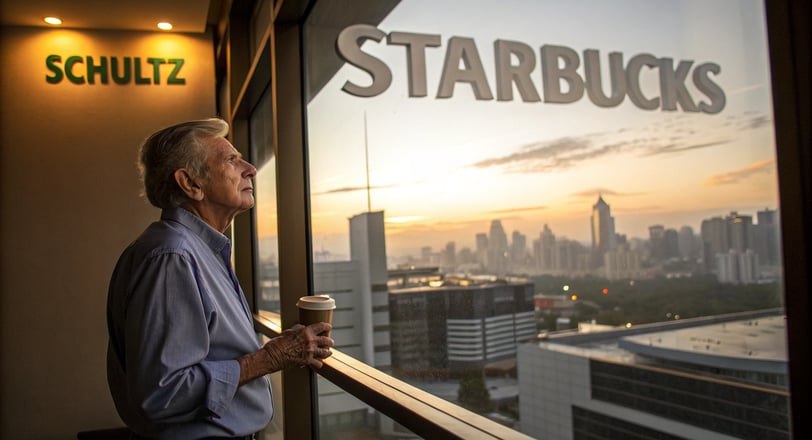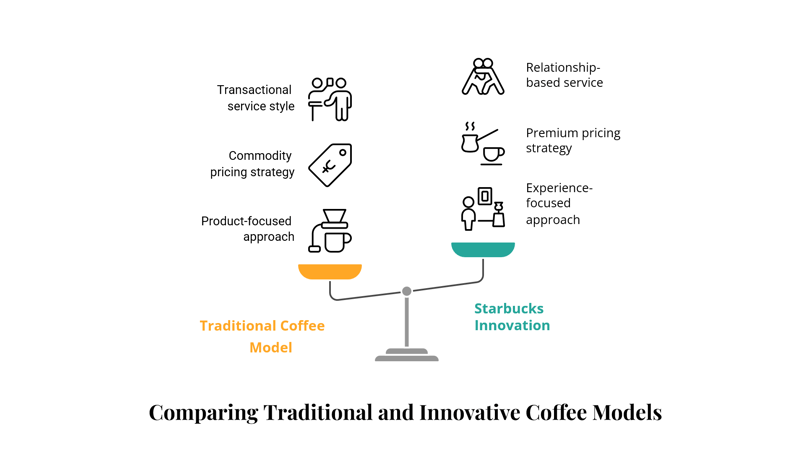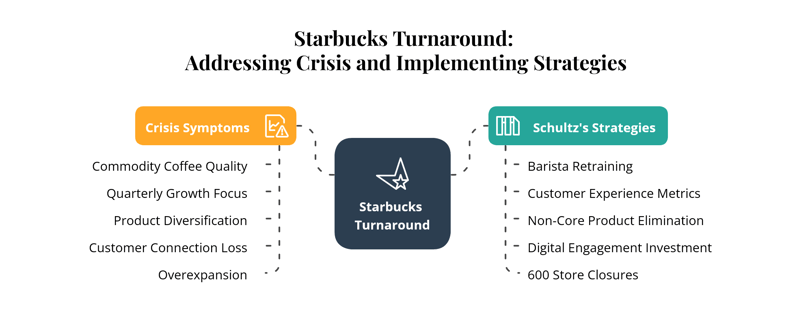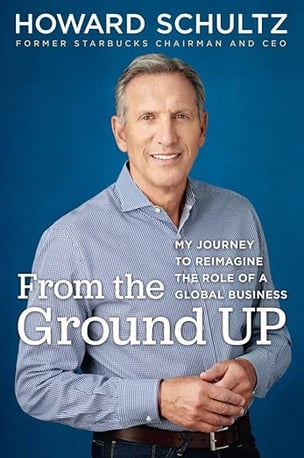From Brooklyn Projects to Global Coffee Empire: Howard Schultz's Entrepreneurial Blueprint
Discover how Howard Schultz went from Brooklyn projects to building Starbucks. Real failures, bold pivots, and strategies you can steal – no fluff, just blueprint.


From Brooklyn Projects to Global Coffee Empire: Howard Schultz's Entrepreneurial Blueprint
In the crowded landscape of business success stories, Howard Schultz's biography stands apart. It's not just another tale of corporate domination – it's a masterclass in vision, resilience, and the power of human connection. His journey from the Bayview Housing Projects to building Starbucks into a global coffee empire offers a treasure trove of insights for today's entrepreneurs.
But let's skip the glossy magazine version. We're diving into the real story – the rejections, the missteps, and the bold moves that transformed a small Seattle coffee bean shop into a company with over 28,000 stores across 77 countries.
The Hustle Before The Grind: Howard Schultz's Early Life
Born July 19, 1953, in the Brooklyn housing projects, Schultz witnessed firsthand what financial insecurity does to a family. His father worked a series of low-paying, unstable jobs that left the family constantly teetering on the edge. This wasn't just childhood poverty – it was the forge that shaped his future business philosophy.
Rather than accepting this as his predetermined fate, Schultz channeled his energy into education and sports. He became the first in his family to attend college, earning a football scholarship to Northern Michigan University – his first major breakthrough in breaking the cycle of poverty.
Key Takeaway: Your origin story isn't just background noise – it's fuel. The challenges you faced before entrepreneurship often shape your most powerful business insights.
The Pivot That Changed Everything
After college, Schultz worked several sales and marketing jobs before joining a small Seattle coffee retailer named Starbucks in 1982. At this point, Starbucks was just a local business selling coffee beans and equipment with a handful of stores.
The game-changer? A 1983 business trip to Milan, Italy. Walking the streets of Milan, Schultz experienced what entrepreneurs dream of – a genuine epiphany. He observed coffee shops serving as vibrant community gathering places where people connected and built relationships around coffee.
"In Italy, coffee is like theater," Schultz would later say. He wasn't seeing a product – he was witnessing an experience.
Rejection: The First Test of Vision
When Schultz returned to Seattle buzzing with ideas about creating Italian-style coffeehouses, the original Starbucks owners rejected his concept. They were content with their coffee bean retail business and skeptical about pivoting to a service model.
This rejection forced a critical choice: abandon the vision or pursue it independently. Schultz chose the harder path, leaving his secure executive position to launch his own coffee shop concept, Il Giornale.
The financing process was brutal. Schultz made over 200 investment pitches before securing the capital needed. Each "no" refined both his vision and his pitch.
Key Takeaway: Rejection doesn't invalidate your vision – it tests your conviction. The entrepreneurs who succeed aren't necessarily the most brilliant, but the most persistent.
The Unexpected Opportunity: Acquisition and Transformation
In a surprising twist, the original Starbucks owners decided to sell their company in 1987. Schultz raised $3.8 million from investors to acquire the Starbucks assets, merging them with his Il Giornale operation.
This acquisition was both vindication and opportunity. Schultz kept the Starbucks name but implemented the coffeehouse concept he had developed – leveraging an established brand while fundamentally reimagining what it could become.
Under Schultz's leadership, Starbucks made the unconventional decision to avoid franchising, insisting on maintaining ownership of all domestic locations to ensure consistent quality and customer experience. This required substantially more capital but gave the company unprecedented control over operations.
The IPO Gamechanger
A critical milestone came on June 26, 1992, when Starbucks held its initial public offering (IPO) on the stock market. The IPO raised $271 million, providing the capital to accelerate expansion across the United States.
Throughout the 1990s, Starbucks underwent explosive growth, orchestrating what would later be called the "coffee wars" that reshaped American beverage consumption. The company wasn't just opening locations – it was creating a premium coffee category that had previously been virtually nonexistent in American consumer culture.
Key Takeaway: Sometimes growth requires capital that only public markets can provide. When your vision demands scale, don't be afraid to pursue the resources to match.
The Unexpected Exit and Global Vision
On June 1, 2000, Schultz made the significant decision to step down as CEO, transitioning to chief global strategist to focus on international expansion. He appointed Orin Smith as his successor to manage domestic operations while Schultz concentrated on developing Starbucks' presence abroad.
This strategic move allowed Schultz to direct his energy toward new markets, particularly China – a traditionally tea-drinking culture that presented unique challenges. He committed to opening one to two stores daily in mainland China, establishing the foundation for what would become one of Starbucks' most important international markets.
The Crisis: When Success Becomes the Problem
By 2007, despite impressive growth, Starbucks faced serious challenges. The looming recession made premium-priced coffee seem like a luxury, and a cultural shift toward supporting local businesses cast Starbucks as a corporate giant threatening independent coffee shops.
However, the most significant problems stemmed from Starbucks' own success. After Schultz stepped away from operations, the company prioritized rapid expansion and quarterly growth metrics over customer experience and product quality. The compromises were numerous:
Shipping pre-ground coffee instead of whole beans
Resteaming milk between orders
Installing taller espresso machines that created barriers between baristas and customers
Introducing breakfast sandwiches that made stores smell like "burnt cheese rather than fresh coffee"
The company diversified far beyond coffee, introducing CDs, books, and even stuffed animals. While these additions boosted short-term profit margins, they progressively undermined the coffee-centric experience that had differentiated Starbucks.
The result? The stock price dropped by 42 percent, and many stores failed – sometimes due to cannibalization from neighboring Starbucks locations.
Key Takeaway: Success can be more dangerous than failure. When growth becomes the goal rather than the result of excellence, the very qualities that created your competitive advantage can erode.
The Comeback: Radical Refocusing
Recognizing the existential threat, Schultz returned as CEO in January 2008 amid the financial crisis. His comeback started with a bold move – closing all 7,100 Starbucks stores for several hours to retrain baristas in the art of making perfect espresso. This decision cost approximately $6 million in lost revenue but sent a powerful message that quality would no longer be compromised.
The turnaround required painful cuts, including closing 600 underperforming locations and laying off thousands of employees. Schultz also slashed operating costs by $580 million through efficiency measures that didn't compromise the customer experience.
Perhaps most significantly, he radically shifted performance metrics, instructing store managers to prioritize customer experience over same-store sales growth. When investors objected to the company no longer publicly reporting same-store sales figures, Schultz held firm, recognizing that this short-term transparency had incentivized behaviors detrimental to long-term success.


Embracing Failure as a Competitive Advantage
Throughout his career, Schultz demonstrated an unusual willingness to acknowledge failure and learn from mistakes. In the 1990s, Starbucks launched a carbonated coffee drink called Mazagran that became a spectacular market failure. Rather than hiding this misstep, Schultz kept a bottle of the failed product on his desk as a reminder to "celebrate, learn from, and do not hide from mistakes."
Ironically, while Mazagran failed as a product, the development process eventually led to the creation of the Frappuccino, which became one of Starbucks' most successful products – demonstrating how failure can lead to unexpected innovation.
Key Takeaway: The entrepreneurs who win long-term aren't those who avoid failure – they're the ones who metabolize failure into future innovation.
The Stakeholder Capitalism Revolution
Beyond business metrics, Schultz's most enduring legacy may be his approach to stakeholder capitalism, which prioritized employees (whom Starbucks calls "partners") alongside shareholders.
In 2014, Schultz launched the Starbucks College Achievement Plan, a groundbreaking partnership with Arizona State University that enabled employees working at least 20 hours weekly to qualify for free tuition through ASU's online courses.
This initiative exemplified Schultz's belief that business success and social responsibility were complementary goals – a perspective shaped by his own experiences of childhood poverty.
The Ultimate Result: Resilient Growth
Schultz's return to Starbucks ultimately proved extraordinarily successful. The company's stock price increased more than twelvefold between 2008 and 2017, with nearly $100 billion added to market capitalization and expansion to over 28,000 stores in 77 countries with a workforce approaching 350,000 employees.
When Schultz stepped down as CEO in December 2016 (assuming the position of executive chairman), he had transformed Starbucks from its 11 original Seattle coffeehouses to a global brand that had fundamentally changed how people experience coffee worldwide.
Entrepreneurial Lessons from the Starbucks Journey
Howard Schultz's path from Brooklyn to building a global coffee empire offers several critical lessons for today's entrepreneurs:
1. Vision Demands Conviction
When Schultz first proposed creating European-style coffeehouses in America, industry experts scoffed at the idea that Americans would pay premium prices for espresso drinks. His willingness to pursue this vision despite widespread skepticism illustrates the importance of entrepreneurial conviction.
2. Scale Without Soul Is a Dead End
During the mid-2000s, Starbucks' focus on expansion and efficiency compromised the quality and experience that had differentiated it. Schultz's honest assessment of these failures and his willingness to make painful short-term sacrifices illustrates the discipline required to maintain entrepreneurial focus amid success.
3. Values Create Value
Schultz's commitment to providing health insurance for part-time employees, creating educational opportunities, and sustainably sourcing coffee didn't just fulfill ethical obligations—these policies created dedicated employees, loyal customers, and resilient supply chains that provided long-term competitive advantages.
4. Your Origin Story Is Your Secret Weapon
Schultz never forgot the lessons of his childhood in Brooklyn's housing projects. Those experiences of financial insecurity directly shaped Starbucks' employee benefits, creating a company that treated workers differently than most retail operations.
5. The Courage to Return and Reinvent
Perhaps most impressively, Schultz had the courage to return to a struggling Starbucks and make radical changes that contradicted conventional business wisdom. This willingness to reinvent rather than defend past decisions ultimately created far more value than continuity would have.
For entrepreneurs today, the Starbucks journey suggests that building sustainable businesses requires looking beyond conventional metrics to create organizations that address deeper human needs for connection, meaning, and community. Howard Schultz transformed not just the coffee industry but redefined the relationship between business and society, creating a template for stakeholder capitalism that continues to influence entrepreneurial thinking today.
What part of this journey resonates most with your entrepreneurial path?


From the Ground Up: My Journey to Reimagine the Role of a Global Business
Former Starbucks CEO Howard Schultz shares his inspiring journey from poverty to building a global brand—revealing leadership lessons and the power of business to drive change.
Explore more


